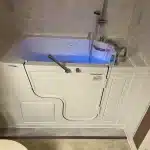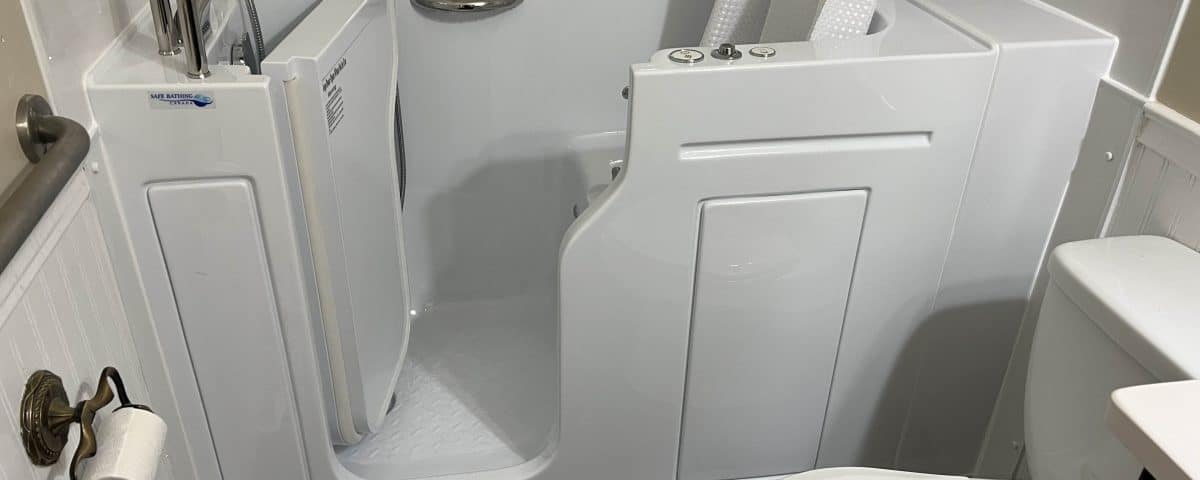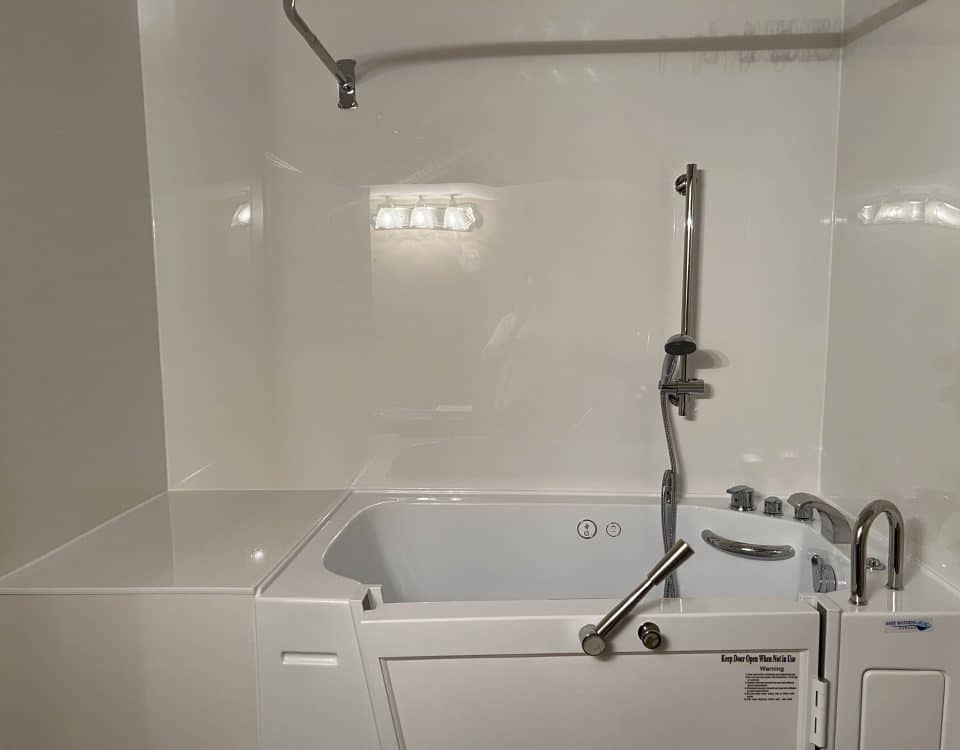
3 Must Haves for the Perfect Walk-In Tub
September 22, 2021
Walk-In Bathtub Professional Installation Vs. DIY
June 20, 2024Introduction
In Canada safety in everyday activities is paramount; bathing is no exception. Traditional bathtubs can pose significant challenges and safety risks, especially for those with limited mobility or disabilities. Walk-in tubs are designed to offer a safer solution. These tubs are intended to accommodate different needs and lifestyles. Throughout this guide, you’ll gain a better understanding of safe bathing in Canada. You will also explore the installation process for walk-in tubs.
Safe Bathing: Understanding Its Importance
Recognizing the importance of safe bathing is crucial before we dive into the installation process. This is especially important for vulnerable populations in society. Statistics show that slips and falls are the top causes of injury-related deaths. This is true, particularly among older adults in Canada.
The bathroom can be a risky place. Its slippery surfaces and confined spaces often lead to accidents. By investing in safe bathing solutions like walk-in tubs, risks can be reduced significantly. This will lead to greater independence and peace of mind for users.
The Benefits of Walk-In Tubs
Walk-in tubs present several advantages which make them a suitable choice for secure bathing in Canada.
- Accessible Design: Walk-in tubs sport low thresholds and doors that swing open. This design enables easy entry and exit, particularly for individuals with mobility issues or disabilities.
- Safety Measures: Tubs of this nature are outfitted with safety elements. They include built-in handrails, non-slip flooring and grab bars. These features work to reduce the risk of accidents and falls.
- Healing Properties: Numerous walk-in tubs boast therapeutic features. These are features like hydrotherapy jets and heated seating. They provide relief from conditions like muscle pain and arthritis.
- Promoting Autonomy: With walk-in tub individuals can bathe independently. They can maintain their dignity and privacy. This independence keeps them from relying on help from others.
The Installation Process of Walk-In Tubs
Now permit us to traverse the process of installing walk-in tubs within Canadian residences.
First, you must decide on the most suitable location. The bathroom is the most common choice. Second, you need to pick the model that fits with your needs. A plethora of options are available.
Third, you should carefully measure the space. Next order your tub based on these measurements. Fourthly, the provision of the necessary plumbing and electrical connections is important.
The fifth step involves the actual installation of the tub. Remember to follow manufacturer instructions closely. A contractor with expertise in these installations would be best.
Afterward, it’s time for the final touches. Sealing edges, testing the tub’s functionality and making sure it’s secure.
Finally, it’s time for cleanup. Discard packaging and debris. Remember, it’s normal for there to be some assembly mess.
Now you have some knowledge regarding a step-by-step installation process of walk-in tubs. In Canadian homes, this could prove to be invaluable for improving accessibility and comfort.
1. Assessment and Measurement
– A certified installer will pay a visit to the home. There they’ll assess the bathroom layout. The suitability of the space for a walk-in tub will then be determined.
– Measurements will be precisely taken. This ensures that the tub fits seamlessly into the designated area.
2. Plumbing and Electrical Considerations
-The installer will assess the current plumbing and electrical systems. This ensures compatibility with the walk-in tub.
-Any required modifications or upgrades will be executed. These accommodate the novel fixture. If necessary rerouting pipes and rewiring will be completed.
3. Removal of Existing Fixture
– If a traditional bathtub or shower is being replaced the installer will remove the old fixture. They will disconnect the plumbing. Electrical connections will also be disconnected, as necessary.
4. Installation of Walk-In Tub
– The walk-in tub will be purposefully set in the assigned area. The aim is to ensure correct alignment and adequate clearance.
– Plumbing and electrical connections will be established. Water supply and drain are included. Optional features like jets or heaters are to be hooked up.
– The tub shall be levelled and attached to the floor. The objective is to deter shifting or instability.
5. Testing and Inspection
– Once installed the walk-in tub is subjected to rigorous testing. The goal is to ensure the correct functionality of all components.
– The tub is inspected by the installer. The focus is on looking for leaks and verifying proper drainage. The installer also assesses key safety features. These include handrails and grab bars.
6. Cleanup and Final Touches
– Debris or packaging materials will be removed from the bathroom. This leaves the space clean and tidy.
– Instructions on the operation and maintenance of the walk-in tub will be provided by the installer. Included will be safety precautions and maintenance tips.
Bathing securely is indispensable, especially for those struggling with mobility limitations or disabilities. A walk-in bathtub presents a functional and accessible alternative. These tubs foster safer and more satisfying bath times for Canadians across different age groups.
Understanding the installation process of these tubs is important. Knowledge of this process allows homeowners to make informed decisions. Proactive measures can then be taken. These steps serve to improve safety and accessibility in their bathrooms.
Enhancing Safety and Accessibility: A Detailed Look at the Walk-In Tub Installation Process
The installation process of walk-in tubs plays a pivotal role in enhancing safety and accessibility in Canadian homes. By understanding each step involved, homeowners can make informed decisions that cater to their specific needs and ensure a seamless installation. Let’s delve deeper into the intricacies of the installation process:
Assessment and Measurement
– A certified installer conducts an on-site assessment to evaluate the bathroom layout. This assessment considers factors such as available space, doorways, and existing plumbing and electrical systems.
– Precise measurements are taken to ensure that the walk-in tub fits seamlessly into the designated area without compromising accessibility or obstructing other bathroom fixtures.
Plumbing and Electrical Considerations
– The installer evaluates the current plumbing and electrical systems to determine their compatibility with the walk-in tub.
– Any necessary modifications or upgrades to the plumbing and electrical systems are undertaken to accommodate the installation of the walk-in tub. This may involve rerouting pipes or rewiring to ensure proper functionality and safety.
Removal of Existing Fixture
– If replacing a traditional bathtub or shower, the installer removes the old fixture. This includes disconnecting plumbing and electrical connections as required.
– Care is taken to ensure that the removal process is carried out efficiently and without causing damage to surrounding surfaces or fixtures.
Installation of Walk-In Tub
The walk-in tub is carefully positioned in the designated area, taking into account factors such as alignment and clearance.
– Plumbing and electrical connections are established, including connections for water supply, drainage, and optional features such as hydrotherapy jets or heaters.
– The tub is levelled and securely attached to the floor to prevent shifting or instability during use.
Testing and Inspection
– Following installation, the walk-in tub undergoes rigorous testing to ensure the correct functionality of all components.
– The installer conducts a thorough inspection of the tub, checking for leaks, proper drainage, and the functionality of key safety features such as handrails and grab bars.
Cleanup and Final Touches
– Once the installation and testing are complete, any debris or packaging materials are removed from the bathroom, leaving the space clean and tidy.
– The installer provides the homeowner with instructions on the operation and maintenance of the walk-in tub, including safety precautions and tips for ongoing care.
Conclusion
In conclusion, the installation process of walk-in tubs is a comprehensive undertaking that involves careful assessment, precise measurements, and meticulous attention to detail. By understanding each step of the process, homeowners can ensure that their walk-in tub is installed correctly and functions optimally, thereby enhancing safety and accessibility in their bathrooms.
To Contact us, please fill out this form.


